Clerkenwell New Prison / House of Detention, Clerkenwell, London
Clerkenwell's 'New Prison' was established in about 1617 as a house of detention for prisoners awaiting trial at the Middlesex Sessions who could no longer be accommodated at Newgate. It was located just to the south-east of the existing Clerkenwell Bridewell at the north end of what became New Prison Walk (now St James's Walk), Clerkenwell. The New Prison site is shown on the 1746 map below.
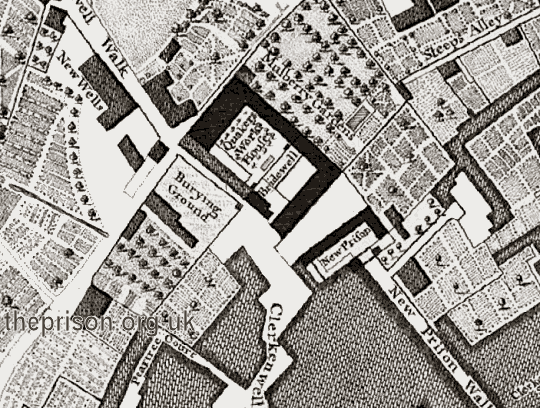
Clerkenwell Bridewell site, Clerkenwell, c.1746.
The building was reconstructed in 1774-5, with an impressive new gateway facing onto St. James's Walk. On its key-stone was 'a gigantic, well-executed head, expressive of criminal horror and anguish' with a chain hanging over it, from which handcuffs were suspended.
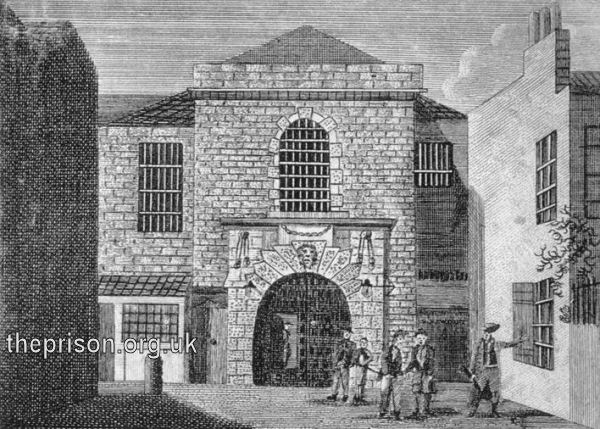
Clerkenwell New Prison gate, Clerkenwell, London, c.1809.
In the Gordon Riots of 1780, the prison was broken into and all the inmates liberated. On 3 September 1781, the prisoners attempted to overpower their keepers and make their escape. By means of notching knives one against the other, they had made instruments with which they sawed off their irons. They attacked and wounded the turnkey, and would have killed him, had not the sergeant of the guard that was in attendance for the protection of the prison come to his assistance. Three of the ringleaders were shot dead on the spot, and twelve others were wounded before the insurgents were subdued.
In 1812, James Neild wrote:
This Prison, built in 1775 has, over the gate-way, two rooms, called "Between Gates," and "Bed-Prison;" each containing three beds. These are occasionally occupied by Prisoners brought in at night, who can pay one shilling the first night, and six-pence every night succeeding; and two sleep in a bed. Others, who cannot pay for this reception, are put into the Strong Room, which is about 16 feet square: On the Women's side of the Prison it has barrack-beds, but no bedding; and is lighted by two iron-grated windows.
Over the Turnkey's Lodge is a bed-chamber, furnished, and called the "Guinea Room," because the Prisoners who occupy it pay one guinea each per week.
From the outer gate is a passage to the gate of the Men's court, on the right hand, and to that of the Women on the left: to each of these, the descent is by six steps.
In the Men's court are two sheds, one 18 feet by 12, the other about 12 feet square, partly enclosed, and without windows. In each there is a table, with shelves for provisions, benches to sit upon, and a fire-place; to which a peck of coals per day is allowed in Summer, and half a bushel during the Winter.
The Gates-Man has a double allowance of bread, half a pound of meat, with the broth in which it is boiled, and a pint of porter daily. He likewise sleeps in the Bed Ward, hereafter noticed. His duty is to attend at the Inner Gate, and assist in cleansing the courts and sleeping wards.
Here are also two Sheds-Men, one of whom acts as Clerk in the Chapel, and the other as a Barber, to shave the Prisoners. They are likewise employed to keep the Prison clean, and receive the same allowance as the Gates-Man. N. B. The Prisoners thus occupied are what they here call Fines, or persons imprisoned for a certain limited time.
The Night Ward, (into which Prisoners are not permitted to go in the day-time, that the air in it may be fresh and cool,) is a building on the side of the court-yard, divided into two apartments. The ground floor of it, on the right, is called "Newgate Ward;" which has barrack-beds, without bedding; and above it is a room with nine wooden bedsteads flock-beds, two blankets to each, two sheets, and a rug; for the use of which each Prisoner pays one shilling the first night, six-pence every night after, and two sleep together. This room is called the "Bed Ward;" and over it, on the attic story, is the Men's sick ward, which has five iron bedsteads, and bedding for single persons; a fire-place also, with iron-grated and glazed windows.
The ground floor, on the left hand, is denominated "the Lower Ward," and has barrack bedsteads, without bedding. The chamber above this is called the "Middle Ward," and set apart for Felons: the attic story is of the same size, and appropriated to Fines. These rooms are of an irregular shape, measuring in the widest parts 32 feet by 28; nearly 10 feet high, and strongly planked all over, but without chimneys.
For the free circulation of air, every room has in front, toward the courtyard, two windows, and three or four backward; all enclosed with iron bars, but, very properly, not glazed. In this court there is a dark cell, of 11 feet by 8 feet 7 inches, and 8 feet 8 inches high; with a barrack bed, for the refractory.
The Women's court has two sheds, or day-rooms, similar to those for the Men, and without windows; one 15 feet by 9, the other 12 feet by 10, with fire-places, coppers, benches, and table. A Gates-Woman is here stationed, who has a double allowance of bread for attending the Gate; and also two Sheds-Women, whose office is to clean the court-yard and sleeping-wards; for which they also have the same allowance of bread, and half a pound of meat daily, but no strong beer. The Prisoners thus employed are likewise called Fines.
On one side of the Women's court-yard, upon the ground floor, is the "Strong Room" before-mentioned; and over it, in a passage, or gallery, are five cabins, called Pigeon Holes, each of 9 feet 4 inches, by 4 feet 2; with a barrack bedstead for two Prisoners, feather beds, and bedding. In the passage room is a wooden turn-up bedstead, with bedding; and every Prisoner sleeping in any of these beds pays one shilling the first night, six-pence every night after, and two sleep in a bed.
Adjoining to the last-mentioned room is another, for Women Fines, 21 feet by 16 feet.9, with barrack-beds, and three windows looking to the court-yard.
Adjoining the Strong Room, and on the ground-floor, is the Lower Ward for women, who cannot pay for beds, but sleep on barrack bedsteads: this is 21 feet long by 16 feet 9, and has three iron-grated windows.
The Women's Infirmary is above stairs, and has five iron bedsteads, with bedding for single persons; it is 25 feet by 15, fitted up with fire-place, glazed windows, cupboard, and other conveniencies. The patients, at the discretion of the Surgeon, are supplied with better diet, &c. and a Woman Prisoner attends as Nurse, who is allowed a double dole of bread, with half a pound of meat, and a pint of porter per day.
The windows of both the men's and women's ward, are, as they should ever be, too high for the occupiers to look out at. All the staircases are of stone; the ground floors and courts are paved. In each court-yard is a pump, with cisterns, and New River water is laid in from the Main.
In the Chapel, the Men Prisoners are seated below, and the Women in the gallery above. Divine Service was well attended, when I was there on Sunday 19th July 1808, and the Prisoners appeared clean.
Witnesses for the Crown are carefully detained between-gates, in order to secure them from the mal-practice of other Prisoners. Here is no oven to purify infected cloathing, nor a bath for personal cleanliness; an essential accommodation, peculiarly needful in so crowded a Prison, especially during the Summer months, and where two thirds of the Prisoners constantly sleep in their wretched habiliments on the bare boards, without even straw afforded them for bedding. Within the gate-way of entrance is affixed a board, on which, very properly, is painted as follows:
| A Table of the Fees | |
| To be taken by the Keeper of New Prison, at Clerkenwell, in the County of Middlesex. | |
| £. s. d. | |
| For keeping and discharging every person committed by a Warrant of Commitment | 0 4 6 |
| For turning the Key at every such Person's Discharge | 0 1 0 |
| For going with any Person before a Justice | 0 1 0 |
| For a Copy of Commitment | 0 1 4 |
| Prisoners brought in by Constables of the Night, and carried before Justices of the Peace, and discharged | 0 2 0 |
| By the Court, | |
| SELBY. | |
| N.B. No Spirituous Liquors allowed to be brought in here. | |
Prisoners are discharged from hence at all hours, after payment of the Fees; but for failure in which they continue to be detained, unless the Magistrate writes "Poor" on the back of their Discharge.
The court-yards here are by much too small for the number of Prisoners: But both might be enlarged, and a salutary separation of the young beginner from the veteran in offence secured, by taking in a part either of the Keeper's Garden, or of the adjacent Field.
No money is given to the Prisoner at the time of discharge, so as to prevent an immediate recurrence to those predatory acts which brought him or her hither.
The Act for preservation of Health is not hung up, but the prohibitory Clauses against Spirituous Liquors are duly exposed for inspection; and the Gaol is kept very clean.
There are Rules and Orders, printed; but, being signed only by the Gaoler, I do not transcribe them.
Formerly, Mr. Wildman, a Salesman in Smithfield, and afterwards, his Widow, sent the Prisoners beef and beer twice a week; but this kind bounty has been discontinued many years, and I have constantly been told that no donations are sent hither now.
The allowance of bread is too scanty, in a place where there is no opportunity afforded of earning any thing by labour; and the want of bedding must at times be most severely felt, as not even straw is allowed to the poor and destitute Prisoners, who must sleep in their rags on the boarded floor.
I do not recollect having ever visited The New Prison, without seeing Lunatics confined in a place so very ill-adapted for them: And, whilst Persons committed for Fines, and lesser offences, are unavoidably associated with the daring and desperate Criminal, that Confinement which was intended for wholesome Correction, can prove no other than a Seminary of Vice; a sure introduction to the most infamous practices.
| 1800, April 15th | 144 | 1806, May 26th | 73 |
| 1801, Dec. 8th | 48 | 1807, Dec. 18th | 55 |
| 1802, Feb. 27th | 76 | 1808, July 11th | 115 |
| 1803, Nov. 4th | 61 | 1809, June 19th | 86 |
| 1804, Aug. 31st | 154 | 1810, May 22d | 116 |
| 1805, April 13th | 140 | 1811, Feb. 16th | 85 |
Allowance, one pound of bread per day, sent from the Baker's, in loaves of 2lbs. weight, every other day.
The prison was largely rebuilt in 1816-18, and extended to incorporporate the sites of the old Clerkenwell Bridewell and Quaker workhouse, together with five houses opposite Short's Buildings, five others in Bridewell Walk, and land previously used as the drill ground of the Clerkenwell volunteers. A report in 1828 recorded that the previous forbidding gateway had been replaced and that now:
On entering, persons are conducted into a paved yard, beyond which appear the various buildings, standing in an oblong area, and with a considerable space between them and the lofty substantial wall which bounds the whole. In front, on one hand, is the porter's lodge; on the other, the office on the right, the governor's house; and beyond that, lying all along the east side, a vegetable garden. Between the office and lodge begins a broad paved avenue; on both sides of which, as the visitor advances, are seen the prisoners' yards and cells. At the farther end, surmounted by a stone turret and clock, is the chapel; to which the male and female infirmaries form wings.
In the report of a committee appointed in 1825 by magistrates, to investigate the condition of this gaol. It is stated that the number of prisoners it was originally intended to contain was two hundred and forty; but upwards of four hundred are frequently incarcerated within it. There is an allowance of one pound and a quarter of bread per diem to each prisoner; and their friends are permitted to visit and bring them provisions daily (Sundays excepted) from twelve till two o'clock; the destitute being provided, at the county's expense, with meat, soup, and gruel.
The wards and cells are of brick, strongly arched; and are covered with lime-white, which is renewed daily wherever necessary. The greatest attention is paid to cleanliness. The beds are of straw, with the addition of blankets and coverlets. In the chapel (in which service is performed every day, and twice on Sundays) the attendants are in some degree classed by divisions of open iron railings; and the females are seated over the male auditors in a gallery, the approaches to which, as well as the gallery itself, are effectually screened from observation. The salary of the chaplain is £250. per annum: his duties are not, as in the case of the House of Correction, confined to the prison. The Governor's salary is £300. Per annum; the apothecary's, for attending both prisons, £400. per annum. Vans, drawn by two horses, are established, and arrive twice a day, for the conveyance of prisoners to and from the different police offices to this gaol, and from hence to the House of Correction, Newgate, &c.
A third reconstruction was carried in 1845-7, when the prison was renamed the Middlesex County House of Detention, Clerkenwell, also known as Clerkenwell Prison. Male and female prisoners awaiting trial for petty offences were remanded there. Its design was based on the radial layout, following that of the model prison at Pentonville
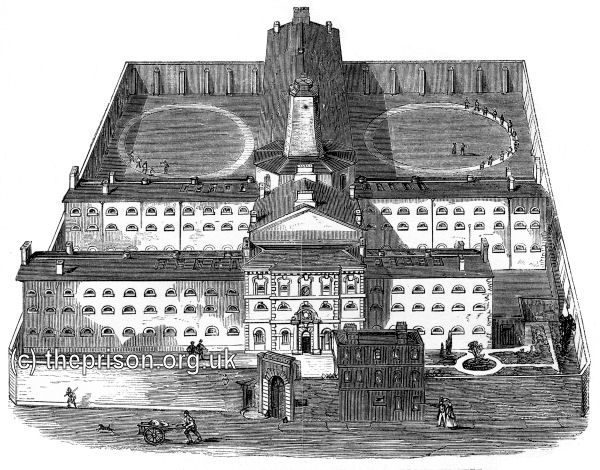
House of Detention bird's-eye view, Clerkenwell, London, c.1862. © Peter Higginbotham
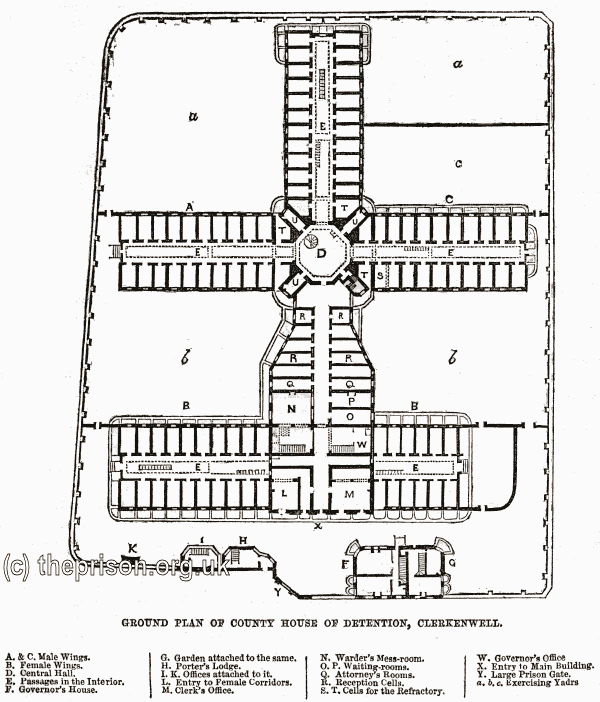
House of Detention ground plan, Clerkenwell, London, c.1809.
An account of a vist to the prison in 1862 reported:
County House of Detention, Clerkenwell.
We were admitted within the prison walls by a door near to the large front gate. Crossing the courtyard, we entered the pillared portal of the prison, and were led into the presence of the governor, who requested the deputy-governor to conduct us over the establishment.
Reception Ward.
There are eight reception cells here, four on each side of the passage, beyond the offices already mentioned. As seen by a reference to the ground plan, the outer cells are widest, and gradually contract towards the innermost one, which is near to the central hall. We found the dimensions of the outermost cell to be nineteen feet two inches in length, five feet eight inches in width, and nine feet at the bottom, and ten feet at the top of the arch. It is floored with asphalt, like the others, and beautifully white washed. The innermost cell is eight feet four inches long, and five feet eight inches wide, and of the same height as the one referred to. Each of them is lighted by a window three feet six inches long, and one foot four inches wide, and is ventilated by a flap in the centre of the window, and from a shaft near the top of the window for cold air, and a grating in the corner of the cell near the door, which admits warm air through a flue.
While visiting these reception cells, a number of warders, in their blue uniforms, were bustling in the long hall preparing to conduct two files of prisoners to the prison vans for trial at the Sessions. One or two of these were respectably dressed, and had been charged with embezzlement. They did not appear to feel very comfortable when ranked up in line with a band of felons. Among the group we discerned one or two sturdy labourers, in their white smock-frocks, and could trace the quick clear eye and roguish look of the habitual felon. As one band was conducted into the prison van, and whirled off, a policeman being seated in front, another detachment was brought from the interior of the prison, and took its place in another van, which also drove off.
We descended to the basement, and found eleven other reception cells, each about half the size of an ordinary cell. They had no furniture except a seat, fixed into the wall. Along side were seven baths for the prisoners, about the same dimensions as the latter reception cells, in addition to a bath for the warders, and one for the governor.
The reception warder informed us: "The prisoners are received here from the county of Middlesex and the metropolitan police courts on this side of the river, with the exception of those in the city. They consist of prisoners on remand, or for trial at the Middlesex Sessions; person in default of bail, deserters from the army, and cabmen for infringing the Hackney Carriage Act. They are generally brought here in vans from the police-courts referred to, or from the county, being occasionally escorted hither by the police. Each constable brings a commitment along with the prisoner, which is handed over to me.
"The prisoners are brought from the van to the outer hall of the prison. The serjeant in charge states the number he has in custody, and from what courts they have come, which is duly entered, after which they are lodged meanwhile in the reception cells above. So soon as the vans have all arrived from the different courts, the prisoners are taken down to the basement, when they are thoroughly searched, their property taken from them, and their names and ages carefully set down. They are then taken to the bath-rooms and cleansed, after which they are formed in line, and the rules of the prison read to them. After this routine they are brought up into the centre of the prison, and distributed to their several wards.
"In the event of any of their garments being in a bad condition, a suit of prison clothing is furnished them, consisting of a dark blue jacket, vest, and trowsers, and good under clothing. Their own clothes being restored to them on their liberation.
"With reference to their discharge," he added, "the warders of the different divisions copy from the commitments the date of release of each prisoner. There are some discharged every morning. At a quarter-past nine o'clock in the morning, each warder brings out such prisoners, who are ranged in line. A list is furnished to the reception warder, from which he calls out the different names, and ascertains if he has the right prisoners, and the courts to which they are to be forwarded. They are then passed by the clerk in the office, and the commitments handed to the police serjeant in the van."
Central Hall.
There is a bright iron gate, in addition to a wooden door, leading from the main building in front into the inner ball. We observe on our right hand a brass tablet recording that the foundation stone of this prison was laid by the most noble the Marquis of Salisbury, on the 4th May, 1846. The central hall has a lofty octagonal roof, lighted from a series of skylights, and by long narrow windows at the extremities of the corridors. There is a spiral staircase communicating with the corridor in front, termed the second division, consisting of three stories with two galleries, named respectively D, E, F. On our right hand is the corridor of the first division, termed A, B, C, and directly opposite is the corridor of the third division, styled G, H, I, the first and second divisions being parallel with the two wings of the female prison in front. The general arrangements of the corridors are so similar to those at Pentonville and other prisons we have already sketched, that a farther description is unnecessary. The central hall and corridors are floored with stone and not with asphalt as at Holloway.
As we looked around us, several of the warders in their blue uniforms, with their stand up collars, ornamented with three sabres on a brass shield, as at Coldbath Fields, were lingering in the central hall, or busy over the galleries, while a number of prisoners were kneeling down beside their pails washing, or stoning the floor. Everything around us had the active, vigorous air of military discipline.
Chapel.
Meanwhile the bell rang for chapel service, and we went up a staircase leading to the governor's seat, alongside the pulpit, as at Holloway Prison. There was only a solitary warder then present, and not a single prisoner could be seen in any of the pews, which sloped upwards along the extensive gallery beneath us. Soon after, a file of prisoners, some of them considerably advanced in life, entered the pews at the back of the gallery, and at the same time a troop of boys occupied those in front. While the male prisoners were assembling, the female portion was coming into the chapel and occupying another gallery behind and above, quite out of sight of the male prisoners; and shortly after the seats were well filled with a numerous audience. Two female warders sat behind the female prisoners, and two male warders took their station on each side of the males. The congregation was of a very motley character. Most of the females were very plainly dressed, and from their appearance and manners, we could easily discern they belonged to the lower order of society. Many of them had coarse masculine features, and were Englishwomen, and not Irish cockneys. We did not see a single pretty girl among them, like some of those we found in Holloway Prison. The generality of the boys were poor and ragged, some of them were very keen eyed and restless in their manner; others were apparently the children of decent parents. The men were very different in their character, one man had the appearance of a swell, with his auburn whiskers stylishly cut, and his locks nicely adjusted over his fine forehead. Another man, in middle life, with a very corpulent paunch, sat before him, dressed in a suit of corduroy. We noticed a silver-headed man in a brown overcoat, who had evidently seen better days.
The Kitchen.
We visited the apartments on the basement, where several prisoners are employed as carpenters, blacksmiths, and painters, connected with the establishment, and having nothing of special interest to record, we passed on to the kitchen, which is about thirty-six feet by twenty-seven. The flooring is of stone, and the roof is built with brick, supported on iron girders and pillars. There are two tables in the centre, for trays and shining tins, along with two dressers. The kitchen is provided with a steam apparatus, and several coppers, one for soup, another for gruel, in addition to a large steamer for preparing meat. There are three small coppers — one for cocoa, a second for potatoes, and one for making beef-tea for the infirmary.
Behind the kitchen is a scullery for washing the tins and trays; it is about twenty-one feet square, and contains several dressers, a sink for washing, and a copper to provide hot water. It is paved with stone, the roof being also supported on pillars.
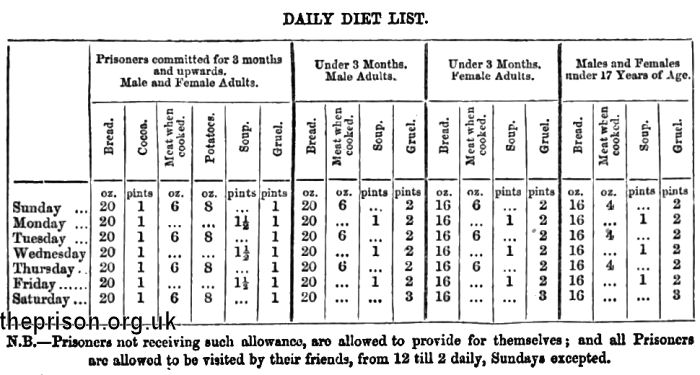
The cook and his assistants commence duty at 7.30 in the morning; breakfast is sent up at 8.30, dinner at 2, and supper at 5.30, ending the operations for the day at 6 o'clock. The cook in his turn, along with the warders, officiates on night duty.
Visiting the Cells.
We accompanied the chief warder to one of the cells in the first division, and found it to be 11 feet long, 7 feet wide, and 8 feet 8 inches high. It is ventilated near the top of the window, and through another iron grating near the floor, at the side of the door, and has a brick roof, and flooring of asphalt. Each of these cells is furnished with a small table, a three-legged stool, a stone night utensil, an iron wash basin, and a coir hammock, kept strapped during the day on two hooks in the wall, and has three triangular shelves for food, utensils, & c. A copy of the rules of the prison is suspended on the wall, with prayers for morning and evening. The door has a trap by which the food is transmitted, in the interior of which is a light iron screen, through which the prisoners are permitted on certain occasions to have communication with their friends. There is also a small circular inspection plate. On the exterior of the door is suspended a small tin case, like an envelope, containing the prisoner's card, with his name, offence, &c. The ordinary cells over the various corridors are of the same dimensions, and similarly furnished. The chief warder informed us "that in the first and second division — A, B, C, D, E, F, were confined parties on remand and for trial at the Middlesex Sessions, while in the third division — G, H, I, were deserters, persons in default of sureties, and cabmen incarcerated under the Hackney Carriage Act.
He stated the A division contained fifty-seven cells, exclusive of a padded one, and three special cells fitted up differently.
We entered one of those special cells. The chief warder remarked, "You see the gas pipe is removed, and a wire-screen is inserted into one of the panes of the window for ventilation, in addition to the apparatus in the ordinary cells. The light is admitted through a glass pane over the door, out of the prisoner's reach. These cells are used for persons who are committed for having attempted to commit suicide.
We went into a padded cell, where a prisoner had been recently confined, who had been suffering under delirium tremens when admitted into the prison. In his frenzy he had torn the wire-screen over the door of his cell, broke the pane of glass, and wrenched off the gas pipes, in an insane attempt to get out of his cell. This cell is of the ordinary size, and is fitted up with coir, packed into the strongest canvas, attached to the walls like panelling. There is a wire-screen over the window, and the flooring is of wood, covered with a thick stuffed coir mattress, for the safety of the prisoner, when in his violent paroxysms. On proceeding into one of the special cells referred to, we saw the wretched inmate, a man of about fifty years of age, who appeared to be a strong-built labouring man. He was now in a convalescent condition, and stated to us "he had recovered his spirits, and was beginning to feel in a more hopeful and bright condition of mind."
As we ascended the staircase leading up into one of the galleries of this corridor, we found a stout lad of about fourteen years of age, dressed in a blue guernsey, and corduroy trowsers, engaged in cleaning. He was confined for threatening his mother-in-law, and appeared to be robust and resolute. The chief warder remarked to us, "Some of the prisoners volunteer to assist in cleaning the prison; some repair shoes, others work as smiths, carpenters, or painters. We cannot compel any of them to labour, farther than to clean their cells."
On going into another cell, we saw the poor coloured man we had noticed in the chapel, He is charged with a petty felony, to which he had been driven by extreme want. He stated he had been a cook on board a vessel, the "Ann," of London, which had been sold off, and he was thereby cast out of employment, and was here a stranger in a foreign land. He belonged to Halifax, North America. His clothes were in a wretched state, and his shoes were hanging in shreds.
In an adjoining cell we found a sharp-featured, pale-faced boy, about fourteen years of age, attired in a drab over-coat, who had been committed the previous day for secreting himself in a railway train. The chief warder, on entering, remarked, "You will hear his story; it is worth the while." The lad stated— "He was an apprentice at a spoon and fork manufactory at Sheffield. His master was cruel to him, and he ran away from his employ ment. His father and mother wished to compel him to stay, but he went into a second class carriage on the Midland Railway, and proceeded to London. On being asked for his ticket by the guard, he pretended he had lost it, and was allowed to proceed to the metropolis, whereupon he was taken into custody. He was to be permitted to write home to his rela tions to acquaint them with his misfortune."
On visiting another cell we saw a profoundly-affecting scene, not uncommon in our detentional prisons. We found a fine-looking genteel boy, with beautiful English features. He had an oval face, blue eye, rosy cheek, and curly hair. He was about twelve years of age, dressed in a dark faded overcoat, and had been charged with stealing from a till. He was very poorly clad, and his shoes were in a wretched condition. He had been urged to steal by two young convicted thieves, who had made him their tool in the business, while they had adroitly managed to escape. Soon after, his mother, a careworn, poverty-stricken woman of about thirty-five years of age, came in, and was in extreme anguish when she saw her little boy. He burst into tears at the sight of his broken-hearted mother, but soon appeared to forget his own distress in her presence. The poor woman was convulsed with agony too deep for tears, and looked as if her heart would break. She pressed her hands to her throbbing temples, and seized hold of our arm to prevent herself from falling. She was led away to a seat outside the door of the cell, and was sitting there in silent anguish as we passed along the gallery.
We proceeded with the chief warder to the central corridor, termed the second division of the male prison, containing about seventy cells. He observed, "We have six strong cells for prisoners who have attempted to escape from prison, or are otherwise desperate characters." On being shown into one of them, we found that in addition to the ordinary iron-framed window there were iron bars on the exterior, and the door was plated in the interior with iron. On looking into several of the cells as we passed along, we did not see anything worthy of special notice.
On visiting the corridor of the third division we got a farther glimpse into the romance of our London prisons, where fact frequently transcends the singular and startling recitals of fiction. We went into a cell where we found an old bald-headed man, with silver hair, bending on his seat, apparently absorbed in some deep and consuming sorrow. He was wrinkled and careworn, and had a long thin face, with a dreamy imbecility in his eye, occasionally kindling into sudden flashes of energy. He was dressed in a shabby worn greatcoat with a velvet collar, a dark spotted vest, and corduroy trowsers. He told us he was a native of Colchester, in Essex, and had loved a woman about forty years ago, but the correspondence between them had been broken off. It seems some wags in Colchester, who knew the weakness of the frail old man, told him, by way of a practical joke, that his Dulcinea resided in London, in a certain locality. He came to London with £17 in his pocket, on a sentimental journey to see her. He endeavoured to force himself into a house to see the object of his affections, against the wish of the inmates, and was given into the hands of the police. He stated he was a farmer in comfortable circumstances, and that his brother was also a large farmer residing near Colchester.
As we passed along one of the galleries we saw a remarkably fine-looking old man, who had been a soldier in the Grenadier Guards, confined for assaulting his wife. He is in custody for six months, as he could not find security for his better behaviour. He was assisting one of the warders.
In another cell we observed a young Irish lad, of about nineteen years of age, in a very shabby tattered dress, like a wretched beggar. He told us he was a gunner in the Artillery, but had for a time deserted, and been labouring as a cooper in the metropolis. At last he got wearied of it and gave himself up as a deserter to return to his former military service. How a man could exchange the comfortable dress of an artilleryman and his cleanly habits, for a life of squalor and rags, is one of those enigmas which cannot be easily explained even by those who know the wild freedom of low life in London! On a subsequent day we saw two fine-looking young artillerymen come to the prison to escort their prodigal companion back to his old quarters.
In an adjoining cell we found a Polish refugee, a stern-looking man, beneath the middle size, whom we had particularly observed in the chapel. He was a soldier in the Polish service up to the year 1830, and had come to Portsmouth with a large detachment of exiles. He now works as a shoemaker. He is in custody for trying to force his way into the presence of the secretary of the Polish Refugee Association.
In another cell, through the inspection plate, we saw rather a notable character, in his way. We had, in our boyhood, heard him address a Scotch constituency, as a candidate for representation of the Montrose Burghs. He was then a handsome young man, who had just written a book (little known) on the French Revolution; and no doubt aspired to great future eminence. Even then he appeared to be rather a crochetty individual, and to be wanting in solid judgment. But how is the picture changed now? See him here in his cell, a blighted being, attired in a shabby dark dress, his countenance the picture of morbid melancholy! The chief warder observed — "He was detained here twelve months for threatening a Scotch Member of Parliament. At the expiry of that time, being unable to find bail for his future conduct, he has been subjected to other twelve months' imprisonment. "
Exercising Grounds.
Before leaving the male prison we visited the various exercising grounds. Two of them are situated at the back of the prison, on each side of the central wing, which is at right angles to the other two wings of the male branch of the establishment. The prisoners we saw here consisted of persons committed for examination and for trial; but as we gave a description of their general appearance during the chapel service, we need not enter into any further detail here. They marched around their circles, similar to the other prisons, under the supervision of several warders. A smart young man, dressed as a sailor, was pointed out to us as a beggar. The chief warder informed us he had burned his arm with caustic, or other chemical ingredient, to create a sore in order to excite the compassion of the public, and had thereby effectually disabled himself in a more serious manner than he had intended. We observed the corpulent man in corduroy going round an inner circle with the little boys. He was an hostler at a public house, and had inflated himself with large potations of porter. He was very unwieldy in his movements.
We went into the smaller exercising ground for prisoners for want of sureties, committed as deserters, or confined under the Hackney Carriage Act. We found a cluster of cabmen of a poorer set walking in company in the square enclosure; and three young deserters generally kept together. We saw the old romantic lover in the brown overcoat, walking quietly, and with melancholy air, apparently engrossed with his own thoughts. The Polish refugee, equipped in a cap and dark coat, walked solitary, looking keenly around him at his companions in tribulation; and the would-be M.P., already referred to, promenaded with his hands in his trowsers pockets. He was attired in a dark frock coat and warm muffler, and was having a quiet interview with the tall old Grenadier guardsman.
To look on the plain exterior of this motley group, who could dream of the romantic events, and eventful changes of their lives, so little apparent to the superficial eye!
The Female Prison.
The female prison extends on each side of the front of the prison, the two wings being connected together, and forming a continuous line in the upper galleries, over the entrance hall of the central main building. We entered the female prison by a door on the left hand, opposite to the clerk's office, and were introduced to the matron of the establishment, who desired an experienced female officer to conduct us over the interior.
We passed down to the basement by a staircase, leading to tho reception hall. There are ten reception cells, five on one side of the ward, and five on the other, alongside of each other. They are about the same dimensions as those on the basement of the male prison, and are furnished with a water-closet in one corner, and a seat in another. There is a handle inside communicating with a signal plate outside the cell. A current of fresh air is admitted through a ventilating apparatus near the top of the cell beside the window.
On the other side of this ward there are four bath-rooms, each containing a composition bath about five feet nine inches long, two feet three inches wide, and two feet four inches deep, with a footboard. Those rooms in the interior of the ward are about the size of an ordinary cell, but those towards the exterior are only three feet wide, and about the size of the reception cells. There is an additional zinc bath. Each bath is supplied with hot and cold water by a cistern heated by a furnace at the outer extremity of the reception ward.
Adjoining the latter bath is a room with an asphalt floor, where prisoners are searched. Contiguous to these there are two dark punishment cells furnished simply with an iron bedstead. The female warder observed to us, "We seldom have any female prisoners confined here."
On the basement there is a small store. We observed two large presses on one side of the room, one of them containing the winter, and the other the summer clothing of the prisoners, which is of a lighter description. The female prisoners' clothing consists of a woollen linsey jacket and skirt, a flannel petticoat, and chemise, blue worsted stockings, a checked cotton handkerchief for the neck, worn underneath the jacket, and a pair of leather shoes, "In summer," added the warder, "the outer dress is of cotton instead of woollen."
The Laundry.
It is situated on the basement in front of the governor's house, in the eastern wing of the female prison. It contains a large copper with taps to admit cold water, and discharge hot water. There are five boxes with two washing troughs in each, supplying hot and cold water, with a footboard in front, and in the farther extremity of this apartment are seven drying-horses similar to those we found in Newgate female prison. The laundry is about thirty-three feet long and thirteen feet wide. In an adjoining room there is a mangle, with a dresser for folding the clothes. Bundles of garments and bedding were piled on the floor.
There is also a wringing machine, as in the laundries at Wandsworth and Newgate. Another apartment is contiguous, in which the clothes are ironed and folded, containing a store for heating the irons. The warder informed us, "There are generally six prisoners employed here daily." At the time of our visit the laundry was deserted, and not a single prisoner was to be seen.
The Corridor, etc.
The two wings of the female prison, although apparently divided by the main building on the exterior, form one long corridor in the interior. There is a slate platform, about sixty feet wide, stretching across the first gallery of the corridor from the female warders' dressing-room to two doors leading up by two staircases to the gallery in the chapel, where the female prisoners are congregated. Another slate platform across the gallery above is only nine feet wide. On the lower gallery there is a large hall thirty feet long and twenty one feet wide, where the bail prisoners exercise, and where the other prisoners occasionally walk in wet weather. It has a lofty ceiling, and the floor is covered with coir matting.
The female warder informed us, "The female branch of the prison is divided into six wards, A, B, C, D, E, F, in addition to ten reception cells. Amounting in all to 112 cells." On entering one of the cells in the corridor, we found it to be eleven feet five inches long, six feet eleven inches wide, eight feet at the bottom, and eight feet ten inches at the top of the arch. It is furnished similar to those in the male prison. On going round several of the cells, we did not find any case of particular interest. The most of the prisoners were confined for common offences.
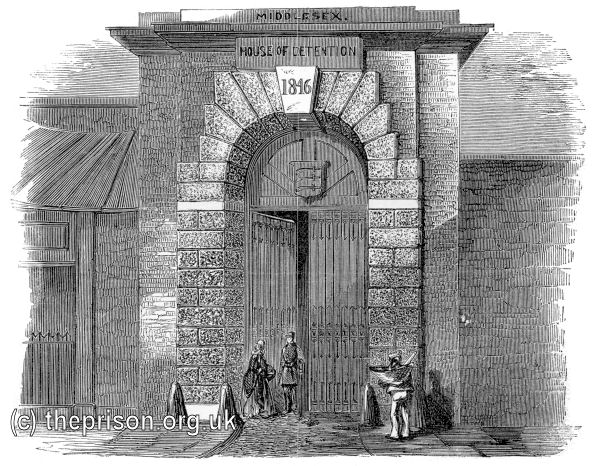
House of Detention front gate, Clerkenwell, London, c.1862. © Peter Higginbotham
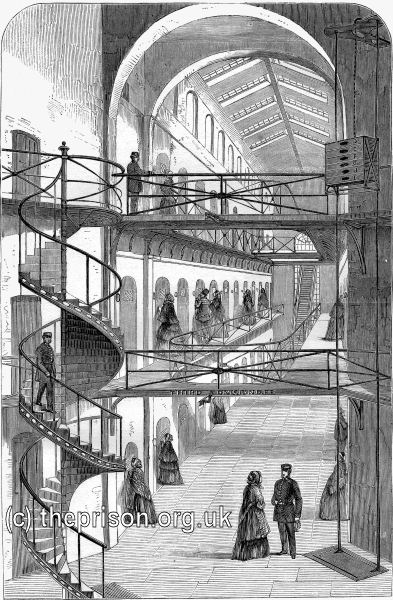
House of Detention visiting time, Clerkenwell, London, c.1862. © Peter Higginbotham
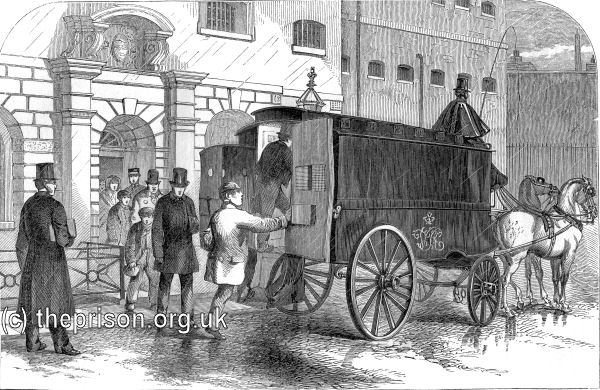
House of Detention prison van, Clerkenwell, London, c.1862. © Peter Higginbotham
The prison is perhaps best remembered due a bomb attack on the site on 13 December 1867, which became known as the Clerkenwell Outrage. In an attempt to free two prominent Fenian (Irish separatist) prisoners, Richard O'Sullivan-Burke and Joseph Casey, a group of their supporters exploded a barrel of gunpowder was exploded alongside the northern perimeter wall of prison, on Corporation Row, causing a sixty-foot breach. However, the prison authorities had received a tip-off earlier in the day and the two inmates had been moved to a secure location. Twelve people were killed in the blast and dozens more injured, and 120 others were injured. The ringleader of the bomb plot, Michael Barrett, was found guilty of murder and became the last person to be publicly hanged at Newgate Prison, on 24 May 1868.
In 1871 the authorities bought the houses on the west side of Woodbridge Street, which were only six feet from the prison wall, allowing the extension of boundary wall and the construction of an additional male cell block and a detached infirmary.
The prison closed in 1886 and was demolished in 1890. In 1893, the London School Board erected the Hugh Myddleton School on the site. The building has now been converted to offices and flats.
During the Second World War part of the basement was altered to form a bomb shelter.[2]
Today, the site of the New Prison and the Clerkenwell Bridewell is occupied by the former Hugh Myddleton School (1893-c.1960), in Bowling Green Lane. A number of the original underground spaces and cells remain and are used for office space or storage. A 2007 adaptation of Oliver Twist used these spaces for filming in July 2007.
Records
Note: many repositories impose a closure period of up to 100 years for records identifying individuals. Before travelling a long distance, always check that the records you want to consult will be available.
- London Metropolitan Archives, 40 Northampton Road, London EC1R OHB. Holdings include: Committee of Visiting Justices minutes (1837-78); Reports to Middlesex Sessions (1847-78); Letter books (1873-77); Rebuilding plans (1846-70); Calendars of prisoners (1730-1821, with gaps); Calendars of prisoners after trial (1690, 1711-74, 1836, 1843-5, 1848-53, with gaps); Register of prisoners for trial including index of convicted prisoners received from the House of Correction, Cold Bath Fields; Index of male prisoners (1876-7); Officers (1847-62).
- The National Archives, Kew, Richmond, Surrey, TW9 4DU. Has a wide variety of crime and prison records going back to the 1770s, including calendars of prisoners, prison registers and criminal registers.
- Find My Past has digitized many of the National Archives' prison records, including prisoner-of-war records, plus a variety of local records including Manchester, York and Plymouth. More information.
- Prison-related records on
Ancestry UK
include Prison Commission Records, 1770-1951
, and local records from London, Swansea, Gloucesterhire and West Yorkshire. More information.
- The Genealogist also has a number of National Archives' prison records. More information.
Bibliography
- Higginbotham, Peter The Prison Cookbook: A History of the English Prison and its Food (2010, The History Press)
- Brodie, A. Behind Bars - The Hidden Architecture of England's Prisons (2000, English Heritage)
- Brodie, A., Croom, J. & Davies, J.O. English Prisons: An Architectural History (2002, English Heritage)
- Harding, C., Hines, B., Ireland, R., Rawlings, P. Imprisonment in England and Wales (1985, Croom Helm)
- McConville, Sean A History of English Prison Administration: Volume I 1750-1877 (1981, Routledge & Kegan Paul)
- Morris, N. and Rothman, D.G. (eds.) The Oxfod History of the Prison (1997, OUP)
- Pugh R.B. Imprisonment in Medieval England (1968, CUP)
Links
- Clerkenwell Prison Rules, 1862.
- Prison Oracle - resources those involved in present-day UK prisons.
- GOV.UK - UK Government's information on sentencing, probation and support for families.
Except where indicated, this page () © Peter Higginbotham. Contents may not be reproduced without permission.



